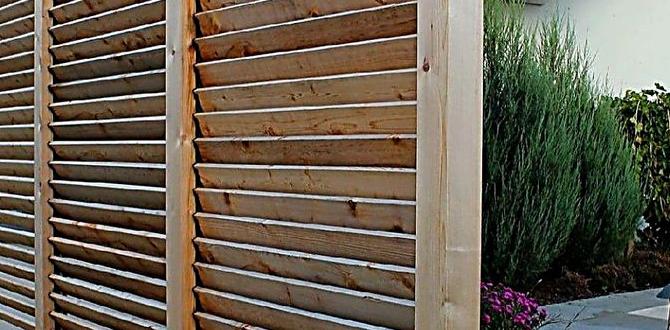Is a Kerosene Heater Safe for Indoors? Essential Safety
Kerosene heaters can be a cozy, cost-effective way to warm a space, but safety is paramount. To answer directly: Yes, a kerosene heater can be safe for indoor use, but only when operated and maintained with strict adherence to safety guidelines. Improper use poses serious risks. This guide will walk you through everything you need to know to use one safely and confidently.
Hey there, fellow eco-enthusiasts and home comfort seekers! If you’re looking to add a bit of warmth to your home without a huge energy bill, you might be curious about kerosene heaters. They’re a popular choice for supplemental heat, especially when power outages hit or in areas where central heating isn’t quite enough. But the big question on everyone’s mind is: are they actually safe to use inside?
It’s completely understandable to have questions. Safety is always the top priority, right? We want to feel warm and snug, not worried. The good news is that with the right knowledge and careful practices, you can enjoy the benefits of a kerosene heater. Think of it like caring for a delicate plant – it needs the right environment and attention to thrive safely.
This guide is designed to be your friendly roadmap. We’ll break down all the essential safety tips, common concerns, and best practices. By the end, you’ll feel much more confident about whether a kerosene heater is the right choice for your home and how to use one responsibly. Let’s get cozy and informed together!
Understanding Kerosene Heaters: How They Work
Before we dive deep into safety, it’s helpful to know a little about what makes a kerosene heater tick. These heaters are pretty straightforward in their design. They draw fuel (kerosene) from a tank, vaporize it, and then burn it to produce heat. The heat is typically radiated into the room. They don’t require electricity, which makes them fantastic for backup heating during power outages.
There are two main types of indoor kerosene heaters::
- Convection Kerosene Heaters: These models heat the air around them, which then circulates naturally throughout the room. They’re generally quieter and heat a larger area more evenly.
- Radiant Kerosene Heaters: These heaters use a ceramic or metal grill to radiate heat directly forward, similar to a camp stove. They provide more immediate, directional warmth.
Both types rely on combustion, which is where the safety considerations come into play. Understanding this basic mechanism helps us appreciate why certain precautions are so vital for preventing accidents like fires or carbon monoxide poisoning.
The Essential Safety Checklist: Is a Kerosene Heater Safe for Indoors?
This is the core of our discussion! The simple answer is that a kerosene heater is safe for indoor use only when you follow proper procedures. Think of these as non-negotiable rules. They’re not here to scare you, but to empower you with the knowledge to stay safe.
1. Ventilation is Non-Negotiable
This is the most critical rule. Kerosene combustion produces carbon monoxide (CO), an odorless, colorless gas that is highly dangerous. Even a small amount can cause dizziness, flu-like symptoms, and at higher concentrations, death.
- Always ensure adequate ventilation. This means cracking a window or turning on an exhaust fan in the room where the heater is operating. The general recommendation is to open a window or vent at least 1–3 inches.
- Never use a kerosene heater in a tightly sealed, unventilated room, such as a small bedroom, a bathroom, or a basement with no airflow.
- Consider installing a carbon monoxide detector. This is a vital safety device for any home that uses combustion appliances, including kerosene heaters, fireplaces, or gas stoves. Test it regularly! You can find reliable CO detectors and learn more about their importance from organizations like the Consumer Product Safety Commission (CPSC)1.
2. Use Only K-1 Kerosene
This is another strict rule for operating your kerosene heater. Not all kerosene is created equal, and using the wrong type can lead to incomplete combustion, soot production, and dangerous fumes.
- Always use high-quality K-1 grade kerosene. This grade is specifically designed for indoor heating and burns cleaner.
- Never use gasoline, diesel fuel, or kerosene additives. These fuels burn hotter, produce more dangerous byproducts, and can damage your heater.
- Store kerosene properly. Keep it in a cool, dry place away from heat sources, direct sunlight, and flames. Use only approved kerosene storage containers.
3. Proper Placement and Clearance
Where you put your heater matters greatly in preventing fires. These heaters get hot, and flammable materials nearby can easily ignite.
- Maintain at least a 3-foot clearance around the heater from any curtains, furniture, bedding, paper, clothing, or any other flammable material.
- Place the heater on a stable, level surface. This prevents it from tipping over.
- Never place a kerosene heater in a high-traffic area where it could be bumped or knocked over accidentally.
- Keep heaters away from doorways and exits to ensure a clear escape path in case of emergency.
4. Never Leave Unattended
Just like candles or an open fire, kerosene heaters should not be left running when you’re not actively supervising them.
- Always turn off and unplug (if electric ignition) the heater when you leave the room, even for a short time.
- Never fall asleep with a kerosene heater operating. This is a common cause of tragic accidents.
- Supervise children and pets closely when the heater is in use. Ensure they understand (or are kept away from) the danger of the hot surfaces and flames.
5. Refueling and Maintenance are Key
Proper refueling and regular maintenance keep your heater operating efficiently and safely.
- Allow the heater to cool completely before refueling. Refueling a hot heater can cause fuel to ignite instantly.
- Refuel outdoors if possible. This minimizes the risk of spills and fumes inside your home.
- Wipe up any spilled kerosene immediately.
- Follow the manufacturer’s instructions for cleaning and maintenance. This typically includes cleaning the wick, checking for damage, and ensuring all parts are functioning correctly. A dirty or worn wick can lead to poor performance and increased safety risks.
- Inspect the heater regularly for any signs of damage, such as dents, cracks, or leaks. Do not use a damaged heater.
6. Proper Storage When Not in Use
When the cold season is over, correct storage is crucial for the heater’s longevity and future safety.
- Follow manufacturer instructions for shut-down and storage. This often involves removing fuel and cleaning the unit.
- Store in a cool, dry, well-ventilated area away from flammable materials and out of reach of children and pets.
Potential Risks Associated with Kerosene Heaters
It’s important to be aware of the potential dangers so you can actively prevent them. Knowing the risks is the first step to mitigating them.
Here are the primary risks:
- Carbon Monoxide (CO) Poisoning: As mentioned, incomplete combustion releases CO. Symptoms can be subtle at first, mimicking a cold or flu. Prolonged exposure or high concentrations can be fatal.
- Fire Hazards: Kerosene is a flammable liquid. Spills, improper refueling, proximity to flammable materials, or tipping over the heater can all lead to fires.
- Burns: The outer surfaces of a kerosene heater can become extremely hot during operation, posing a burn risk to people and pets.
- Indoor Air Pollution: Even with proper ventilation, burning kerosene can release particulate matter and other air pollutants into your home, which can be problematic for individuals with respiratory conditions like asthma.
Kerosene Heater Vs. Other Heating Methods
It’s helpful to see how kerosene heaters stack up against other common heating options, especially concerning safety and efficiency.
Here’s a comparison:
| Heating Method | Pros | Cons | Indoor Safety Considerations |
|---|---|---|---|
| Kerosene Heaters | Portable, good for power outages, cost-effective fuel, heats quickly. | Requires manual refueling, needs good ventilation, potential for spills/fires, distinct odor. | High risk of CO poisoning and fire if not used with strict ventilation and clearance protocols. |
| Electric Heaters (e.g., space heaters) | Easy to use, no fumes, generally safe if certified (e.g., UL listed), thermostat control. | Higher electricity cost, potential fire hazard if faulty or placed near flammables, reliant on power. | Lower risk of toxic fumes; fire risk from electrical faults or proximity to flammables still exists. Overheating can be a concern. |
| Propane/Natural Gas Heaters (Vented) | Efficient, can be very safe when properly vented, thermostat control. | Requires professional installation for permanent units, requires fuel source, initial cost can be higher. | Very safe when properly vented to the outdoors. Unvented units pose similar CO risks to kerosene heaters. |
| Wood Stoves | Creates a cozy atmosphere, uses a renewable fuel, can be very efficient. | Requires significant space for stove and wood storage, regular maintenance (chimney sweeping), can be messy, initial cost. | Fire risk from embers/sparks, requires proper ventilation (chimney), potential for chimney fires if not maintained. |
As you can see, while kerosene heaters offer unique benefits, their safety demands are significantly higher than many electric options or properly vented gas heaters. The key takeaway is that all heating methods require responsible use.
Choosing the Right Kerosene Heater for Indoor Use
If you decide a kerosene heater is for you, selecting the right model is the first step to safe operation.
Key Features to Look For:
- Safety Shut-off Features: Some models have tip-over switches that will extinguish the flame if the heater is knocked over. This is a valuable safety feature.
- Built-in Fuel Gauge: Helps you avoid overfilling the tank and know when you’re running low.
- Odorless or Low-Odor Design: While no kerosene heater is completely odor-free, some are designed to minimize emissions and smell.
- CSA or UL Certification: Look for heaters that have been tested and certified by a recognized safety organization like Canadian Standards Association (CSA) or Underwriters Laboratories (UL). This indicates the product meets specific safety standards.
- Portability: Consider how easy it is to move the heater where you need it most.
What to Avoid:
- Unlabeled or Generic Heaters: Stick to reputable brands that provide clear instructions and safety information.
- Second-hand Heaters with Missing Parts or Damage: Unless you’re experienced in heater repair, it’s best to buy new or from a trusted source.
- Heaters Not Designed for Indoor Use: Some kerosene heaters are strictly for outdoor use and are not safe for enclosed spaces. Always confirm the heater is marked for indoor use.
Step-by-Step Guide to Safe Kerosene Heater Operation
Let’s walk through the process of using your heater safely. Remember, these steps are crucial for your well-being.
Before You Light It Up:
- Read the Manual: Seriously, this is step zero! Every heater is a bit different. Understand your specific model’s features and safety warnings.
- Inspect the Heater: Check for any damage, clean any dust, and ensure the wick is in good condition and properly adjusted according to the manual.
- Choose the Right Location: Find a stable, level surface at least 3 feet away from any flammable materials, walls, doors, and high-traffic areas.
- Ensure Ventilation: Open a window or vent at least 1–3 inches. If you have a CO detector, ensure it’s working.
- Use K-1 Kerosene: Make sure you have clean, fresh K-1 kerosene.
Lighting Your Kerosene Heater Safely:
- Refuel Outdoors (if possible) OR ensure the heater is cool and in a well-ventilated area.
- Fill the tank carefully, ensuring not to overfill. Wipe up any spills immediately.
- Allow the kerosene to soak into the wick for at least 15–20 minutes (check your manual for specific soak times). This is essential for a clean burn.
- Ignite the wick according to the manufacturer’s instructions. Use a long utility lighter or match.
- Adjust the flame to the proper height as indicated in your manual. A yellow, flickering flame indicates it’s too high or the wick needs trimming. A steady, blue-tinged flame is ideal.
- Close protective grills securely.
During Operation:
- Monitor the flame and heat output.
- Keep the area around the heater clear.
- Do NOT leave unattended.
- Ensure ventilation remains adequate.
Extinguishing and Refueling:
- Turn the heater off by turning the control knob to the “OFF” position.
- Allow the heater to cool DOWN COMPLETELY. This can take 30 minutes or longer.
- Once cool, you can refuel it, again following the outdoor refueling recommendation or ensuring good ventilation.
Frequently Asked Questions (FAQs)
Q1: Can I use a kerosene heater in my garage or basement?
A1: Using a kerosene heater in an attached garage or a basement requires extreme caution and excellent ventilation. Garages can contain flammable vapors from cars, and basements are often poorly ventilated. Always ensure you have open windows/vents and a working CO detector.
Q2: My kerosene heater smells strongly. Is this normal?
A2: A faint odor when lighting or extinguishing is somewhat normal, but a strong, persistent smell during operation usually indicates a problem. It could be low-quality fuel, a dirty or improperly adjusted wick, or insufficient ventilation. Check your fuel, clean the wick, and improve airflow immediately. If the problem persists, stop using the heater.
Q3: How often do I need to ventilate the room?
A3: You should ensure continuous ventilation for as long as the heater is in operation. Keeping a window cracked open is generally recommended. The goal is to allow fresh air in and any combustion byproducts out.
Q4: What kind of kerosene is best?
A4: Always use K-1 grade kerosene. It’s the cleanest-burning grade and is specifically recommended for indoor heaters. Avoid K-2 or K-3 grades, which are less refined and produce more fumes and soot.
Q5: Can I run a kerosene heater overnight while I sleep?
A5: No. This is extremely dangerous and strongly advised against by manufacturers and safety organizations. Never fall asleep with a kerosene heater operating, as the risk of fire or carbon monoxide poisoning is too high.
Q6: How do I know if my kerosene heater is producing too much carbon monoxide?
A6: The best way is to have a working carbon monoxide detector. If it alarms, turn off the heater immediately, open all windows and doors, and evacuate. If you experience symptoms like headaches, nausea, dizziness, or confusion while the heater is on, turn it off and seek fresh air. These could be signs of CO exposure.
Q7: My heater is leaving black soot on the walls. What does that mean?
A7: Soot production is a sign of incomplete combustion. This can be caused by using the wrong type of fuel, a wick that is too high, a dirty wick, or improper ventilation. Ensure you’re using K-1 kerosene, your wick is clean and properly adjusted according to the manual, and that you have sufficient airflow. Persistent soot formation indicates an unsafe operating condition.
Conclusion: Warmth With Responsibility
So, is a kerosene heater safe for indoors? You’ve learned that the answer hinges entirely on responsible use. When operated with constant vigilance, proper ventilation, the correct fuel, and adherence to all manufacturer guidelines, these heaters can provide effective and economical warmth.
The key to enjoying a toasty room with a kerosene heater lies in respecting its power and understanding its potential risks. Think of it like tending to your herb garden – giving it the right conditions, regular care, and knowing what it needs to thrive safely. By prioritizing the safety checklist, understanding the risks, and





